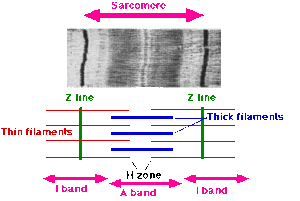Sarcomere
| Parent |
| Muscle fibrils |
| Subordinate |
|
Microfilaments Myosin filaments I-band (biology) A-band (biology) |
| Gene Ontology |
|---|
| QuickGO |
The sarcomere (from the Greek σάρξ sárx, gen . Σαρκός sarkós “meat” and μέρος méros “part”) is the smallest functional unit of the muscle fibrils (myofibrils) and thus the muscles .
Each sarcomere is mainly made up of three microscopic, contractile proteins that are composed of filaments (protein threads) made up of actin , myosin and titin . The sarcomere has a strict, regular structure and is arranged in the longitudinal direction of the myofibril, which in turn is directed along the muscle fiber , and lined up one behind the other. At rest it is about 2 to 2.5 micrometers long.
Sections of the sarcomere
The Z-disks (" Z wischen" disks , also called Z-strips or Z-lines), which are connected to the relatively thin and therefore lighter actin filaments, delimit the sarcomere at its ends.
"Hang" on the Z-discs on both sides of actin filaments (engl .: thin filament ) are the thick and therefore darker in the microscopic image myosin filaments between the ends thereof. An actin filament protrudes into two neighboring sarcomeres.
The myosin filaments are connected to two adjacent Z-disks via the elastic protein titin and are thus centered in the middle of the sarcomere.
The protein family of the myosins provides the motor proteins of actin. There are more than 15 different classes known, each with several sub-types. Typically, a myosin molecule consists of a tail, which is connected to other structures ( vesicles to be transported ) or another myosin tail , and a head. The myosin head is an ATPase , which means it can split ATP and use the energy gained to change the angle of the head. Since the head can bind to actin filaments, the molecule moves along the filament. In the middle of the sarcomere, and thus also of the myosin (engl .: thick filament ) are the M slices ( M edium slices, strips or also S-M-called lines). It is assumed that M and Z disks serve to mechanically stabilize the actin and myosin filaments.
The area around the M-disks is called H-zone designated ( H Ensen zone named after Victor Hensen ), there are only myosin. The area around the Z-disks is called the I-band ( I = isotropic ), there are only actin filaments. The area between two I-bands is called the A-band ( A = anisotropic ).
The myosin filament is linked to the M and Z disks via the elastic titin filament, which is bound to the myosin filament and runs to the M disk. According to current knowledge, the titin filament is supposed to center the myosin filament between the Z-disks during the contraction and take on a spring function, so it is coiled like a spring towards the Z-disks. The ends of the actin and myosin / titin filaments overlap. In summary, the sequence of the sarcomere sections looks like this: Z - I - A - H - M - H - A - I - Z. A sarcomere therefore consists of one A-band and two half I-bands.
Muscle contraction
During a muscle contraction , the actin filaments move together with the Z-disks in the direction of the M-disk and the myosin filaments connected to them. Although the filaments do not change their own length during contraction, with the exception of titin, the length of the sarcomere changes: When contracting, the sarcomere becomes shorter, when stretching it becomes longer.
aching
The repair processes of micro-injuries to the Z-disks, which are mainly caused by eccentric (i.e. decelerating) muscle work, are a possible explanation for sore muscles .
literature
- Jeremy M. Berg, John L. Tymoczko, Lubert Stryer : Biochemistry. 6th edition, Spektrum Akademischer Verlag, Heidelberg 2007, ISBN 978-3-8274-1800-5 .
- Donald Voet, Judith G. Voet: Biochemistry. 4th edition, John Wiley & Sons, New York 2011, ISBN 978-1-11813992-9 .
- Bruce Alberts , Alexander Johnson, Peter Walter, Julian Lewis, Martin Raff, Keith Roberts: Molecular Biology of the Cell , 4th Edition, Taylor & Francis 2002, ISBN 978-0-81533218-3 .


